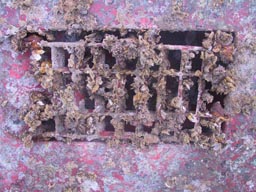
Sea Chests
Sea chests are the intake areas for ballast water in the hulls of large ships. Sea chests have been demonstrated to house and transport a wide variety of organisms. Grates or screens over the sea chest may prevent large organisms from being entrained in the ballast water of ships, however, even larger species such as adult crabs and fish have been found inside sea chests. Indeed the list of marine species found inside ships' sea chests includes sponges, sea anemones, hydroids, worms, sea slugs, mussels, oysters, scallops, bryozoans, barnacles, crabs, sea stars, sea urchins, sea squirts and fish (Cawthron Institute, New Zealand).

The increase in anti-fouling paint technology has generally decreased the amount of fouling on the hulls of merchant vessels, however, many "nooks and crannies" including rudders, gratings, holes, and sea chests remain difficult to paint and thus subject to high levels of fouling. Thus while a ship can be 99% free of fouling organisms, the remaining 1% that remains fouled is all that is needed to introduce a species to a new habitat.